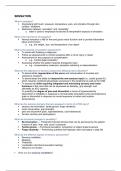Summary
Summary Sensation Assessment
- Course
- Institution
Highly detailed summary of the content for all the Sensation Assessment lectures. Includes work from lecture slides, textbook/reading annotations and external research where further explanation was needed.
[Show more]



